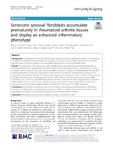| dc.contributor.author | Del Rey, Manuel J. | |
| dc.contributor.author | Valín, Álvaro | |
| dc.contributor.author | Usategui, Alicia | |
| dc.contributor.author | Ergueta, Sandra | |
| dc.contributor.author | Martín, Eduardo | |
| dc.contributor.author | Municio, Cristina | |
| dc.contributor.author | Cañete, Juan D. | |
| dc.contributor.author | Blanco García, Francisco J | |
| dc.contributor.author | Criado, Gabriel | |
| dc.contributor.author | Pablos, José L. | |
| dc.date.accessioned | 2020-03-10T11:27:41Z | |
| dc.date.available | 2020-03-10T11:27:41Z | |
| dc.date.issued | 2019-11-05 | |
| dc.identifier.citation | Del Rey MJ, Valín Á, Usategui A, Ergueta S, Martín E, Municio C, et al. Senescent synovial fibroblasts accumulate prematurely in rheumatoid arthritis tissues and display an enhanced inflammatory phenotype. Immun Ageing. 2019;16(29) | es_ES |
| dc.identifier.issn | 1742-4933 | |
| dc.identifier.uri | http://hdl.handle.net/2183/25148 | |
| dc.description.abstract | [Abstract] Background
Accumulation of senescent cells has been associated with pro-inflammatory effects with deleterious consequences in different human diseases. The purpose of this study was to analyze cell senescence in human synovial tissues (ST), and its impact on the pro-inflammatory function of synovial fibroblasts (SF).
Results
The expression of the senescence marker p16INK4a (p16) was analyzed by immunohistochemistry in rheumatoid arthritis (RA), osteoarthritis (OA), and normal ST from variably aged donors. The proportion of p16(+) senescent cells in normal ST from older donors was higher than from younger ones. Although older RA and OA ST showed proportions of senescent cells similar to older normal ST, senescence was increased in younger RA ST compared to age-matched normal ST. The percentage of senescent SA-β-gal(+) SF after 14 days in culture positively correlated with donor’s age. Initial exposure to H2O2 or TNFα enhanced SF senescence and increased mRNA expression of IL6, CXCL8, CCL2 and MMP3 and proteins secretion. Senescent SF show a heightened IL6, CXCL8 and MMP3 mRNA and IL-6 and IL-8 protein expression response upon further challenge with TNFα. Treatment of senescent SF with the senolytic drug fenofibrate normalized IL6, CXCL8 and CCL2 mRNA expression.
Conclusions
Accumulation of senescent cells in ST increases in normal aging and prematurely in RA patients. Senescence of cultured SF is accelerated upon exposure to TNFα or oxidative stress and may contribute to the pathogenesis of synovitis by increasing the production of pro-inflammatory mediators. | es_ES |
| dc.description.sponsorship | Instituto de Salud Carlos III; FIS 16/00032 | es_ES |
| dc.description.sponsorship | Insituto de Salud Carlos III; RETICS RD16/0012 RIER | es_ES |
| dc.language.iso | eng | es_ES |
| dc.publisher | BMC | es_ES |
| dc.relation.uri | https://doi.org/10.1186/s12979-019-0169-4 | es_ES |
| dc.rights | Atribución 3.0 España | es_ES |
| dc.rights.uri | http://creativecommons.org/licenses/by/3.0/es/ | * |
| dc.subject | Rheumatoid arthritis | es_ES |
| dc.subject | Synovial fibroblasts | es_ES |
| dc.subject | Aging | es_ES |
| dc.subject | Cell senescence | es_ES |
| dc.subject | SASP | es_ES |
| dc.title | Senescent synovial fibroblasts accumulate prematurely in rheumatoid arthritis tissues and display an enhanced inflammatory phenotype | es_ES |
| dc.type | info:eu-repo/semantics/article | es_ES |
| dc.rights.access | info:eu-repo/semantics/openAccess | es_ES |
| UDC.journalTitle | Immunity and Ageing | es_ES |
| UDC.volume | 16 | es_ES |
| UDC.issue | 29 | es_ES |









